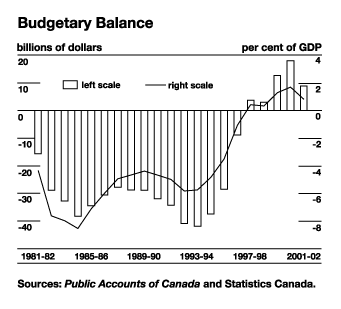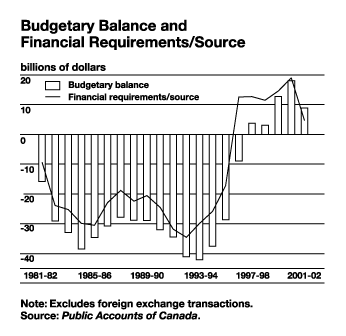|
|
Annual Financial Report 2001-2002: 1
- Table of Contents - Next -
Fiscal Year 2001–2002
A budgetary surplus of $8.9 billion was recorded in 2001-02. This marks the fifth consecutive year in which the federal government has recorded a surplus – the last time this occurred was in the period up to 1951-52. As a result of the budgetary surpluses recorded since 1997-98, the net debt has been reduced by $46.7 billion to $536.5 billion from its peak of $583.2 billion in 1996-97.
The federal government achieved a surplus in an environment in which most other major economies recorded deficits. This is attributable to stronger-than-expected economic growth in the latter half of the fiscal year and prudence in budget planning, ensuring that monies are not committed without the assurance that we will not go back into deficit.
Because of this prudence, even in the uncertain economic environment of 2001, the Government was able to act to address a number of key priorities. It legislated and implemented the tax cuts announced in the February 2000 budget and October 2000 Economic Statement and Budget Update, which provided timely stimulus to the economy. In addition, in the aftermath of the September 11th terrorist attacks, it acted quickly to enhance the security of Canadians and to provide a boost to confidence in the economy.
Net debt as a percentage of the economy was just over 49 per cent in 2001-02, a reduction of almost 22 percentage points from its peak of about 71 per cent in 1995-96. On an international basis Canada has made more progress in reducing its debt burden than any other Group of Seven (G-7) country. According to the Organisation for Economic Co-operation and Development, Canada’s net debt burden is now below the G-7 average – well below those in Italy and Japan and in line with those in Germany and France. Only the United Kingdom and the United States have lower debt levels.
This large reduction in public debt is important for a variety of reasons. A lower debt burden means that a smaller portion of the revenue the Government collects from taxpayers must go towards debt-servicing payments, thereby leaving more resources for reducing taxes and funding valued programs and services. A lower debt burden also lessens the exposure of Canada’s fiscal situation to economic shocks, especially an increase in interest rates or prolonged slowdowns in economic activity. And a lower debt burden reduces the amount that younger Canadians will have to pay for servicing debt incurred by the generations that preceded them.
The financial data in this report are based on the audited results, which will appear in more detail in the 2002 Public Accounts of Canada, scheduled for tabling in the House of Commons this fall. They cover the federal government’s spending and revenue performance for the past fiscal year (April 1, 2001 to March 31, 2002) and detail the factors affecting these results. In addition, the Fiscal Reference Tables publication has been updated to incorporate the results for 2001-02 and historical revisions to the National Economic and Financial Accounts published by Statistics Canada. These tables are an integral part of this report.
The Honourable John Manley, P.C., M.P.
Deputy Prime Minister and Minister of Finance
Note to Readers
The Canada Customs and Revenue Agency (CCRA) collects personal income taxes on behalf of the Government and all provincial and territorial governments except Quebec. On January 29, 2002, the CCRA announced it had identified a problem in tax accounting that resulted in overpayments to provinces under the tax collection agreements. On September 4, 2002, the Minister of Finance announced that the Government of Canada would recover $1.4 billion of the amounts overpaid for the years 1997 to 1999 and use the money to pay down the debt. The net present value of these amounts has been recast to the fiscal years to which they apply. In addition, once the problem was discovered, the federal government took immediate action to prevent further overpayments related to 2000 and subsequent taxation years. This has resulted in a transfer of $1 billion from the tax collection agreements with respect to taxation year 2000 to budgetary revenues in 2000-01. As a result, the budgetary surplus has been revised upward beginning in 1997-98 as shown in the table below.
Revisions to the Budgetary Surplus
|
|
||
| Originally published | Revised | |
|---|---|---|
|
|
||
|
($ billions) |
||
| 1997-98 | 3.5 | 3.8 |
| 1998-99 | 2.9 | 3.1 |
| 1999-00 | 12.3 | 12.7 |
| 2000-01 | 17.1 | 18.1 |
|
|
||
Report Highlights
|
The Budgetary Balance
Economic growth in most major economies slowed sharply in the first half of 2001, reflecting the impact of higher interest rates and energy prices and a sharp decline in global high technology investment. The events of September 11th introduced a further shock to the global economy through disruptions in economic activity and sharp declines in confidence. Like all other countries, Canada was impacted by these developments. Economic growth slowed considerably, from 4.5 per cent in 2000 to only 1.5 per cent in 2001.
However, Canada was much better positioned to cope with the global slowdown than in previous global downturns due to much healthier finances, the timely tax reductions announced in the October 2000 Economic Statement and Budget Update, low and stable inflation, declining net foreign debt and historically low interest rates. As a result, the economy did not slow as much as in other countries. Indeed, Canada avoided the U.S. recession and growth rebounded strongly in the first half of 2002.
In the October 2000 Economic Statement and Budget Update, May 2001 Economic Update and December 2001 budget, the Government committed to a balanced budget or better for 2001-02. The final budgetary surplus for 2001-02 was $8.9 billion. All of this has been applied to reducing Canada’s net debt.
The budgetary balance went from a deficit of 5.8 per cent of GDP ($42 billion) in 1993-94 to five consecutive surpluses over the 1997-98 to 2001-02 period. The 2001-02 surplus was 0.8 per cent of GDP ($8.9 billion). Nearly three-quarters of the improvement from 1993-94 is attributable to the decline in program spending – from 16.5 per cent of GDP in 1993-94 to 11.6 per cent of GDP in 2001-02, with the remainder attributable to lower public debt charges.

Net Debt
The 2001-02 surplus of $8.9 billion brings the federal government’s net debt – the accumulation of annual deficits and surpluses – down to $536.5 billion from its peak of $583.2 billion in 1996-97. As a share of GDP, net debt dropped to 49.1 per cent in 2001-02, down nearly 22 percentage points from the peak of 70.9 per cent in 1995-96. This ratio is generally recognized as the most appropriate indicator of the debt burden as it measures debt relative to the ability of the Government and the country’s taxpayers to finance it. This is the sixth consecutive year in which the debt-to-GDP ratio has declined, and it is the lowest the ratio has been since 1984-85.
Net debt consists of interest-bearing debt and other liabilities, net of financial assets. Interest-bearing debt, in turn, consists of unmatured, or market, debt and the Government’s obligations to internally held accounts – primarily the liabilities for the federal government employees’ pension plans. In 2001-02 total interest-bearing debt declined by $5.8 billion: market debt declined by $4.1 billion and obligations to pension accounts declined by $1.7 billion. Other liabilities fell by $3.0 billion, while financial assets increased by $0.1 billion.

Financial Requirements/Source
Financial requirements/source measures the difference between cash coming in to the Government and cash going out. Most industrialized countries use a measure comparable to the financial requirements/source as their main measure of the budgetary balance.
There was a financial source (excluding foreign exchange transactions) of $4.7 billion in 2001-02 – the sixth consecutive year Canada has recorded a financial source – the only G-7 country to do so.
In 2001-02 there was a net requirement of $1.8 billion relating to foreign exchange transactions, down from a net requirement of $8.8 billion in 2000-01. Including this amount, the financial source in total was $2.9 billion, down from a source of $10.2 billion in 2000-01.

Table 1
Financial Highlights
|
|
|||||
| 1997-98 | 1998-99 | 1999-00 | 2000-01 | 2001-02 | |
|---|---|---|---|---|---|
|
|
|||||
|
($ billions) |
|||||
| Budgetary transactions | |||||
| Revenues | 153.5 | 155.9 | 166.1 | 179.6 | 173.3 |
| Program spending | -108.8 | -111.4 | -111.8 | -119.3 | -126.7 |
|
|
|||||
| Operating balance | 44.8 | 44.5 | 54.4 | 60.2 | 46.6 |
| Public debt charges | -40.9 | -41.4 | -41.6 | -42.1 | -37.7 |
|
|
|||||
| Budgetary balance | 3.8 | 3.1 | 12.7 | 18.1 | 8.9 |
| Non-budgetary transactions | 8.9 | 8.4 | 1.9 | 0.8 | -4.2 |
|
Financial requirements/source (excluding foreign exchange transactions) |
12.7 | 11.5 | 14.6 | 19.0 | 4.7 |
| Foreign exchange transactions | -2.2 | -5.7 | -6.8 | -8.8 | -1.8 |
|
|
|||||
| Net financial requirements/source | 10.6 | 5.8 | 7.7 | 10.2 | 2.9 |
| Net change in borrowings | -9.6 | -6.9 | -4.0 | -10.0 | -4.1 |
| Net change in cash balances | 1.0 | -1.1 | 3.7 | 0.2 | -1.2 |
| Financial position | |||||
| Total liabilities | -638.5 | -640.3 | -638.7 | -632.9 | -624.1 |
| Total financial assets | 59.2 | 64.0 | 75.1 | 87.5 | 87.6 |
|
|
|||||
| Accumulated deficit (net debt) | -579.4 | -576.3 | -563.5 | -545.4 | -536.5 |
| Financial results (% of GDP) | |||||
| Budgetary revenues | 17.4 | 17.0 | 16.9 | 16.9 | 15.9 |
| Program spending | 12.3 | 12.2 | 11.4 | 11.2 | 11.6 |
| Public debt charges | 4.6 | 4.5 | 4.2 | 4.0 | 3.5 |
| Budgetary balance | 0.4 | 0.3 | 1.3 | 1.7 | 0.8 |
| Net debt | 65.6 | 63.0 | 57.5 | 51.2 | 49.1 |
|
|
|||||
| Note: Results for 1997-98 to 2000-01 have been revised to reflect the misclassification of mutual fund trust capital gain refunds. | |||||
- Table of Contents - Next -
| Last Updated: 2002-10-16 | |||||